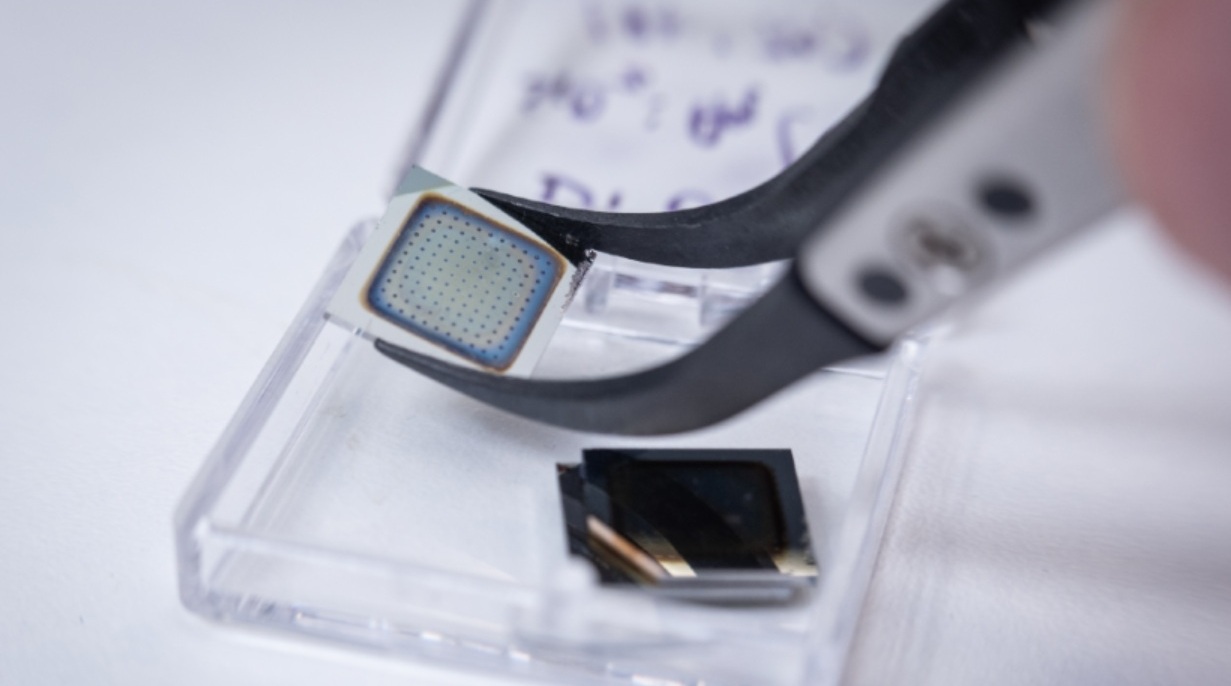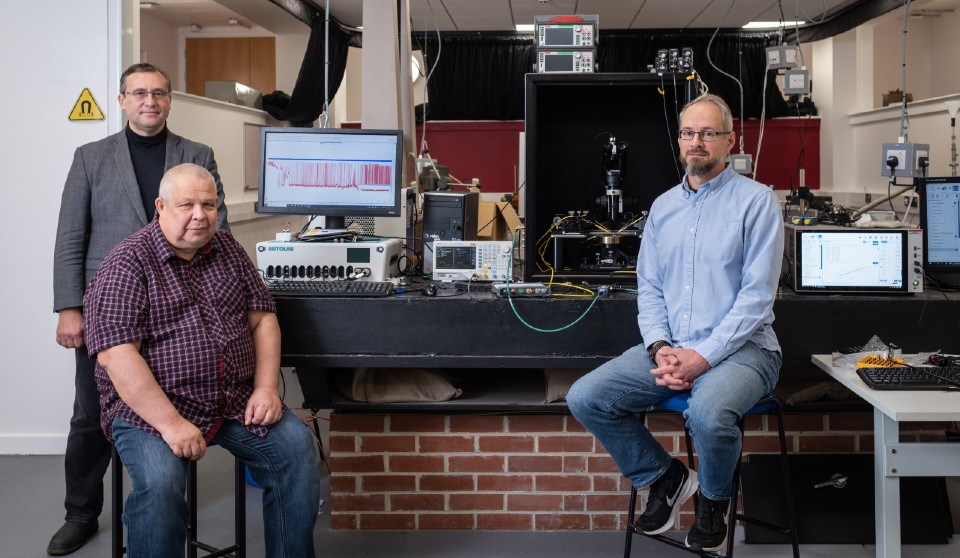Artificial neurons – tiny electronic circuits that replicate the way brain cells communicate – lie at the heart of neuromorphic computing, a field aiming to bring human-like intelligence to machines.
Despite rapid progress, today’s artificial neurons can only perform fixed tasks, each serving a narrow role. Thousands must be combined to replicate simple brain functions – a costly, energy-hungry process compared with the brain’s effortless adaptability.
Now, brain-like intelligence may be closer than we think, thanks to an international research team led by Loughborough University that includes academics from Salk Institute and the University of Southern California.
In a new Nature Communications paper, the team reveals that their single artificial neuron – known as a ‘transneuron’ – can switch between the roles of brain cells involved in vision, planning, and movement, showing a level of flexibility once thought unique to the human mind.
 An electronic chip used to create an artificial transneuron - a tiny electronic circuit that replicates how brain cells pass signals between one another by generating small electrical pulses.
An electronic chip used to create an artificial transneuron - a tiny electronic circuit that replicates how brain cells pass signals between one another by generating small electrical pulses.
“Is the human brain a mysterious device beyond our reach or could we one day recreate it with electronics – and perhaps even build something more powerful?” asks Professor Sergey Saveliev, an expert in theoretical physics at Loughborough University and corresponding author on the study.
“Our research takes a step toward answering this question. We’ve shown that a single artificial neuron can be tuned to reproduce the behaviour of visual, motor, and pre-motor neurons.
“This opens the door to developing electronic chipsets capable of performing complex brain-like functions – from interpreting visual information to controlling movement and actions – all within small devices that use only a handful of artificial neurons. Ultimately, this paves the way for more human-like robots.”
Study findings
The researchers tested how closely their device mimics the brain by feeding electrical signals into the transneuron and measuring the pulses it produced in response. They then compared these with the electrical pulses that real brain cells use to communicate, recorded from macaque monkeys.
The team focused on three key brain regions: one involved in vision processing, another in movement control, and a third that helps prepare for action. Each produces its own distinct pattern of pulses – sometimes steady, sometimes irregular, sometimes in rapid bursts.
Remarkably, by adjusting the device’s electrical settings, a single transneuron was able to reproduce all three types of pulse behaviour, with 70-100% accuracy.

From left to right, Professor Alexander Balanov, Professor Sergey Saveliev, and Dr Pavel Borisov, of the Loughborough University Department of Physics. The team is pictured with the experimental setup used to capture how their artificial transneuron responded to electrical input, mimicking activity in different parts of the brain.
“Our brains are very efficient, able to perform complex tasks like recognising faces or controlling movements while using very little energy”, explains Professor Alexander Balanov, Professor of Physics at Loughborough University.
“By adjusting the settings of our devices’ electric circuits, such as changing the voltage, we can make the same unit act like different brain neurons. We also know that our artificial neurons respond well to changes in the environment, like pressure and temperature, which could be used to create artificial sensory systems.
“All of this could lead to future computers that are much faster and use less energy than todays, and even robots that can change their behaviour in real time, just like living creatures.”
Beyond imitation: artificial transneuron computes like the brain
Crucially, the researchers demonstrated that the transneuron doesn’t just copy how neurons behave – it computes like them too.
When the researchers changed the electrical signals going into the device, the transneuron adjusted how often it generated electrical pulses – much like brain cells that alter their activity depending on incoming signals.
When it was fed two signals at once, the transneuron responded differently depending on whether the signals arrived together or out of sync. This suggests the transneuron can tell signals apart – something that usually takes multiple artificial neurons working together.
How artificial transneurons work
Like other artificial neurons, the researchers’ transneuron is a tiny electronic chip that mimics how brain cells pass signals between one another by generating small electrical pulses.

Electronic chips used to create artificial transneurons - tiny electronic circuits that replicate how brain cells pass signals between one another by generating small electrical pulses. They are pictured in front of the experimental setup used to capture how they responded to electrical input.
Its brain-like flexibility comes from a newly discovered component called a memristor – a nanoscale device that physically changes when electricity flows through it, letting it ‘remember’ past signals and adjust its response, like how brain cells learn.
When electricity flows through the transneuron, silver atoms inside the memristor shift to form and break microscopic bridges, producing the small electrical pulses.
Changes to the memristor’s environment – such as temperature, voltage, and resistance – change the behaviour of the pulses.
This is how the researchers can tune the transneuron to behave like different parts of the brain without any software control.
“Most of today’s artificial intelligence runs on computers that crunch numbers very differently from the way our brains work”, says Dr Sergei Gepshtein, an expert in visual perception and visually-guided behaviour at Salk Institute.
“Your laptop or phone processes information in rigid, step-by-step logic, while the brain relies on vast networks of neurons that fire in irregular, often unpredictable patterns.
“Our transneuron moves us closer to creating hardware that doesn’t just simulate brain-like activity in software but actually works in a brain-like way.”
Creating an artificial nervous system for robots
The next challenge, researchers say, is to create a ‘brain cortex on a chip’ – integrating multiple transneurons into interconnected networks capable of perception, learning, and control.
The team believes this technology could revolutionise robotics by providing the foundation for a robotic nervous system – allowing machines to sense, adapt, and respond to the world more like living organisms.
“This work marks a small but significant step toward building robots with artificial nervous systems”, says Professor Joshua Yang an electrical and computer engineering expert at the University of Southern California.
“Such systems could enable robots to learn more efficiently, using less energy, time, and data.
“They could also support continuous, lifelong learning – adapting seamlessly as new experiences are encountered. These efficiencies and capabilities remain a challenge for today’s artificial intelligence systems."
Using transneurons in the human brain
Dr Pavel Borisov, experimental physicist at Loughborough University, says the research could also help us understand our own brains.
“This brings us a little closer to recreating at least a small part of the brain in electronic form,” he said.
“Devices like those reported in this paper could one day be used to talk and listen to the human central nervous system, and to replace or complement certain areas of our brain.
“On the other hand, the artificial neurons can be a sandbox playground for neuroscientists trying to understand how brain areas communicate with each other, or even to get a better understanding of how our consciousness is formed.”
The international team that developed the transneuron brings together researchers from Loughborough University, the Salk Institute, the University of California San Diego, the University of Southern California, Washington University School of Medicine, University of Massachusetts, Amherst, and Texas A&M University.
